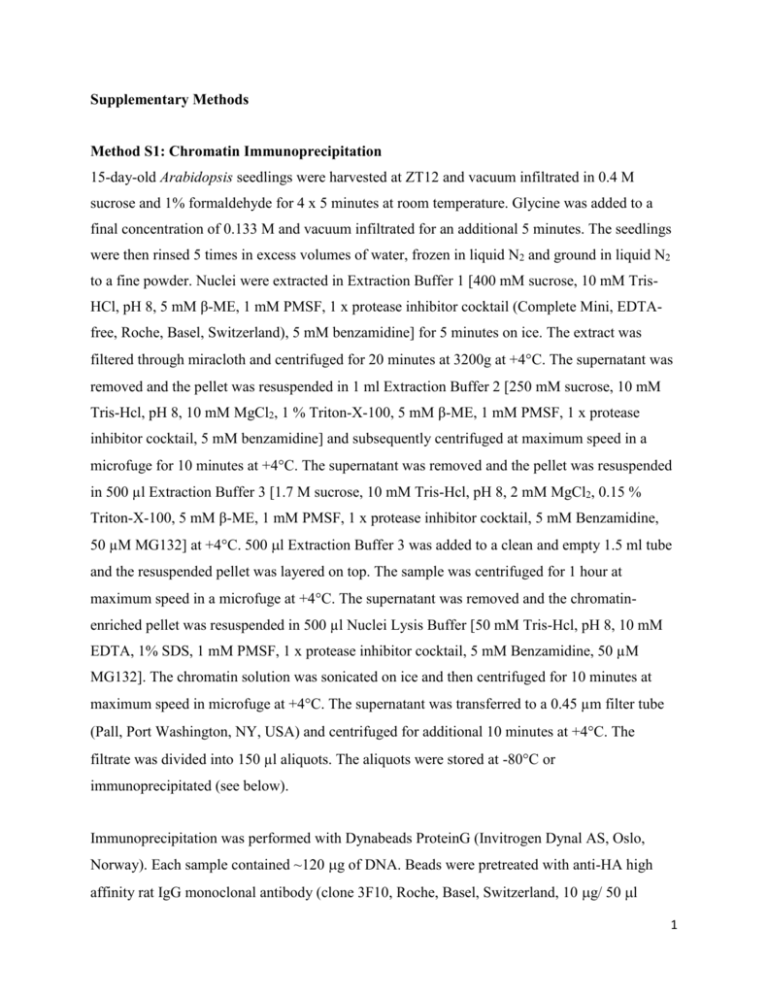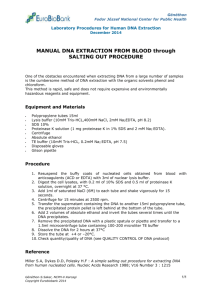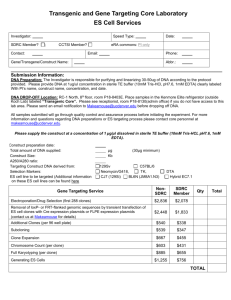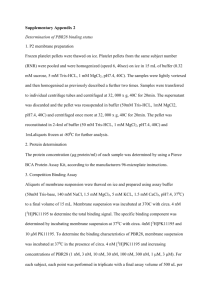tpj12276-sup-0011-AppendixS4-S7
advertisement

Supplementary Methods Method S1: Chromatin Immunoprecipitation 15-day-old Arabidopsis seedlings were harvested at ZT12 and vacuum infiltrated in 0.4 M sucrose and 1% formaldehyde for 4 x 5 minutes at room temperature. Glycine was added to a final concentration of 0.133 M and vacuum infiltrated for an additional 5 minutes. The seedlings were then rinsed 5 times in excess volumes of water, frozen in liquid N2 and ground in liquid N2 to a fine powder. Nuclei were extracted in Extraction Buffer 1 [400 mM sucrose, 10 mM TrisHCl, pH 8, 5 mM β-ME, 1 mM PMSF, 1 x protease inhibitor cocktail (Complete Mini, EDTAfree, Roche, Basel, Switzerland), 5 mM benzamidine] for 5 minutes on ice. The extract was filtered through miracloth and centrifuged for 20 minutes at 3200g at +4C. The supernatant was removed and the pellet was resuspended in 1 ml Extraction Buffer 2 [250 mM sucrose, 10 mM Tris-Hcl, pH 8, 10 mM MgCl2, 1 % Triton-X-100, 5 mM β-ME, 1 mM PMSF, 1 x protease inhibitor cocktail, 5 mM benzamidine] and subsequently centrifuged at maximum speed in a microfuge for 10 minutes at +4C. The supernatant was removed and the pellet was resuspended in 500 µl Extraction Buffer 3 [1.7 M sucrose, 10 mM Tris-Hcl, pH 8, 2 mM MgCl2, 0.15 % Triton-X-100, 5 mM β-ME, 1 mM PMSF, 1 x protease inhibitor cocktail, 5 mM Benzamidine, 50 µM MG132] at +4C. 500 l Extraction Buffer 3 was added to a clean and empty 1.5 ml tube and the resuspended pellet was layered on top. The sample was centrifuged for 1 hour at maximum speed in a microfuge at +4C. The supernatant was removed and the chromatinenriched pellet was resuspended in 500 µl Nuclei Lysis Buffer [50 mM Tris-Hcl, pH 8, 10 mM EDTA, 1% SDS, 1 mM PMSF, 1 x protease inhibitor cocktail, 5 mM Benzamidine, 50 µM MG132]. The chromatin solution was sonicated on ice and then centrifuged for 10 minutes at maximum speed in microfuge at +4C. The supernatant was transferred to a 0.45 µm filter tube (Pall, Port Washington, NY, USA) and centrifuged for additional 10 minutes at +4C. The filtrate was divided into 150 µl aliquots. The aliquots were stored at -80C or immunoprecipitated (see below). Immunoprecipitation was performed with Dynabeads ProteinG (Invitrogen Dynal AS, Oslo, Norway). Each sample contained ~120 g of DNA. Beads were pretreated with anti-HA high affinity rat IgG monoclonal antibody (clone 3F10, Roche, Basel, Switzerland, 10 g/ 50 l 1 beads), rabbit anti-GFP polyclonal antibody (Ab290, Abcam, Cambridge, MA; 4 g/ 50l beads), or rat IgG (mock control, Jackson Immuno Research, West Grove, PA, USA, 10 g/ 50 l beads). Chromatin extracts were diluted 1:10 with ChIP Dilution Buffer [16.7 mM Tris-HCl, pH 8, 1.2 mM EDTA, 167 mM NaCl, 1.1 % Triton-X-100, 1 mM PMSF, 1 x protease inhibitor cocktail, 5 mM Benzamidine, 50 µM MG132]. 1200 l of diluted chromatin solution was immunoprecipitated with anti-HA beads for 2 hours at +4C under rotation. 120 l of the chromatin suspension was used as Input Control. The beads were then washed once with low salt wash buffer [20 mM Tris-HCl, pH 8, 2 mM EDTA, 150 mM NaCl, 0.5 % Triton-X-100, 0.2 % SDS], once with high salt wash buffer [20 mM Tris-HCl, pH 8, 2 mM EDTA, 500 mM NaCl, 0.5 % Triton-X-100, 0.2 % SDS], once with LiCl wash buffer [20 mM Tris-HCl, pH 8, 2 mM EDTA, 0.25 M LiCl, 1 % NP40, Igepal, 0.5 % Deoxycholate], and twice with TE [50 mM TrisHCl, pH8, 10 mM EDTA]. After the wash, the chromatin was eluted twice with 100 µl Elution Buffer [50 mM Tris-HCl, pH 8, 10 mM EDTA, 1 % SDS], whereas the Input control sample was diluted 1:2 with Elution Buffer. After incubating at +65C overnight, the DNA was treated with Proteinase K (0.2mg/ml, Roche, Basel, Switzerland) for 2 hours at +65C. The DNA was purified using the QIAquick PCR Purification kit (Qiagen, Hilden, Germany) and eluted in 50 µl of the Qiagen EB. Method S2: Library preparation for sequencing. For each library, we pooled 5 (Experiment I) and 12 (Experiment II) individual immunoprecipitated DNA and respective input DNA using QIAquickR PCR Purification Kit (Qiagen, Hilden, Germany). The pooled DNA-samples were first end-repaired using the EndItTM DNA End-Repair Kit (EpicentreR Biotechnologies, Madison, WI, USA) according to manufacturer protocol. The samples were incubated at room temperature for 45 minutes. The DNA was purified using QIAquickR PCR Purification Kit (Qiagen, Hilden, Germany) and eluted in 36 l EB. ATP was added to the 3′ ends using Klenow (3′→5′ exo-) (New England BioLabs, Ipswich, MA, USA). 34 µl end-repaired DNA was mixed with 5 μl 10 x NEBuffer 2/Klenow buffer (final conc 1 x), 10 μl 1 mM dATP and 1 μl Klenow (3′→5′ exo-) (5U/μl) and incubated for 30 minutes at +37C. The DNA was purified using MinEluteR PCR Purification Kit (Qiagen, Hilden, Germany) and eluted in 13 l EB. 2 Adapters were ligated to the DNA with A-overhang using LigaFastTM Rapid DNA Ligation System (Promega, Madison, WI, USA). For adapter sequences see Dataset S3. 11 μl DNA was mixed with 15 μl 2 x Rapid Ligation Buffer/DNA ligase buffer, 1 μl Adapter oligo mix (diluted 1:50), 3 μl T4 DNA ligase (3U/l) and incubated for 15 min at room temperature. The DNA was purified using MinEluteR PCR Purification Kit (Qiagen, Hilden, Germany) and eluted in 25 l EB. The DNA was PCR-amplified using Finnzymes PhusionR Flash High-Fidelity PCR Master Mix (New England BioLabs, Ipswich, MA, USA) and primers 1.1 and 2.1 (Dataset S2). 23 µl DNA was mixed with 25 μl 2x master mix PhusionR Flash DNA polymerase and 1.75 μl primer mix (12.5 M each) and amplified: 30 seconds at +98C; 18 cycles of 10 seconds at +98C, 30 seconds at +65C and 30 seconds at +72C; with a final extension of 15 minutes at +72C. The amplified DNA was separated using a 2% low melting point agarose gel (Agarose Low Melt from USB). A band in the range of 150-300 bp was excised with a clean razor blade. The DNA was purified using QIAquickR Gel Extraction Kit (Qiagen, Hilden, Germany) and eluted in 50 l EB. The DNA size and quality was controlled using the BioAnalyser DNA high sensitivity kit (Agilent, Santa Clara, CA, USA) and Fluorometer Qubit (Invitrogen, Carlsbad, CA, USA). Single end Illumina sequencing-by-synthesis was performed by the Michigan State University Research Technology Support Facility. Method S3: Confirmation of PRR7 binding by ChIP-qPCR For the confirmation of PRR7 binding to the targets identified in our ChIP-Seq experiments we used the line 35S::HA-PRR7 #54 (Farre and Kay 2007). We have carried out ChIP-qPCR experiments on CCA1 and LHY promoters using the prr7 PRR7::HA-PRR7 #151 line and observed almost identical IP/Input ratios as the ones measured using 35S::HA-PRR7 #54 shown in Figure S1. For example, using prr7 PRR7::HA-PRR7 the IP/input value for region 6 on the CCA1 promoter was 0.013 0.0085 (average range, n=2) and for region 3 on the LHY promoter 0.0048 0.00025 (average range, n=2). These values are very close to the ones shown on Figure S1 measured using the 35S::HA-PRR7 line. Therefore, we found it acceptable 3 to use the 35S::HA-PRR7 plants for our validation experiments. Method S4: ChIP-Seq Data Analysis. Sequences were preprocessed using the FASTX toolkit (http://hannonlab.cshl.edu/fastx_toolkit/) to filter out adapter sequences (fastx_clipper) and low quality reads (fastq_quality_trimmer). The minimum read length was set at 30 bp and the minimum quality threshold was set at 20. Reads that failed to meet the above criteria were not analyzed further. The preprocessed reads were aligned to the Arabidopsis TAIR10 genome using Bowtie (Langmead et al., 2009) with the -m option to exclude reads that can align more than once to the genome. The rest of the Bowtie parameters were set to default. SAMtools (Li et al., 2009) was used to visualize the Bowtie alignments in the Integrative Genomics Viewer (Robinson et al., 2011). To analyze sequences that successfully aligned to the Arabidopsis genome, QuEST (Valouev et al., 2008) was used to identify binding sites and determine the false discovery rate (FDR). The type of experiment was specified as a “transcription factor with defined motif and narrow (punctate) binding site resulting in regions of enrichment 100-300 bp wide.” The binding site calling parameters were set to the relaxed option and the peak shift lower threshold was set at 10. The rest of the QuEST parameters were set to default. In Experiment I, each immunoprecipitated sample from prr7-3 PRR7::HA-PRR7 and prr7-3 were compared to their respective inputs as negative controls. 685 binding sites were identified in prr7-3 PRR7::HA-PRR7 and 143 binding sites in prr7-3 with FDRs of 6.1% and 1.2%, respectively. We defined common binding sites as those located within 500 bp, and found 11 binding sites in common between the two sets, resulting in 674 sites specific to prr7-3 PRR7::HA-PRR7 (Dataset S1, Figure S7). A comparison of the immunoprecipitated prr7-3 PRR7::HA-PRR7 to the immunoprecipitated prr7-3 as a negative control resulted in the identification of 644 sites with an FDR of 45% in Experiment I (Figure S7). Although we did not use this comparison for downstream studies, both types of analyses led to an almost identical set of binding sites; a comparison of the 674 sites to the 644 sites resulted in 611 binding sites in common between the two sets of analyses (Figure S7). Based on this data, we found it sufficient to compare the immunoprecipitated prr7-3 PRR7::HA-PRR7 to the immunoprecipitated prr7-3 as a negative control for Experiment II. In Experiment II, reads were randomly discarded from 4 the immunoprecipitated prr7-3 PRR7::HA-PRR7 until the total number closely matched the total number of reads from the immunoprecipitated prr7-3 negative control in order for QuEST to calculate FDR values. 298 prr7-3 PRR7::HA-PRR7 specific binding sites were identified in Experiment II with a 2.7% FDR (Dataset S1). We observed a higher percentage of putative PRR7 targets upregulated in the prr579 mutant in Experiment II than Experiment I (Figure S7b). The percentage of genes displaying cycling gene expression in Experiment I was closer to the genome-wide percentage than for genes associated with common binding sites (Figure S7c). Experiment I did not display an enrichment of binding sites in upstream regions close to transcriptional start sites as we observed for Experiment II and the common binding sites (Figure 1, Figure S7 d-e). These observations suggest that a large number of false positive binding sites are present in Experiment I, and therefore, we took a conservative approach by further studying sites identified in both Experiments I and II. QuEST generated wig files to visualize binding sites in the Integrative Genomics Viewer (Robinson et al., 2011). The binding sites determined by QuEST were compared to TAIR10 genes to associate binding sites to putative target genes. Genes were associated to binding sites located within 1000 bp upstream of the transcriptional start site to 1000 bp downstream of the transcriptional stop. Multiple peaks associated with one gene or multiple genes associated with one peak were retained. Common targets from Experiment I and II, along with the independently confirmed binding sites, were used for further analysis. To analyze the distribution of binding sites, we binned their location every 50 bp, up to 1000 bp upstream from the transcriptional start or 1000 bp downstream from the transcriptional stop. For the binding sites located in the intragenic region, we determined which intron or exon the binding site was located based on TAIR10. REFERENCES Blasing, O.E., Gibon, Y., Gunther, M., Hohne, M., Morcuende, R., Osuna, D., Thimm, O., Usadel, B., Scheible, W.R. and Stitt, M. (2005) Sugars and circadian regulation make 5 major contributions to the global regulation of diurnal gene expression in Arabidopsis. Plant Cell, 17, 3257-3281. Edwards, K.D., Anderson, P.E., Hall, A., Salathia, N.S., Locke, J.C., Lynn, J.R., Straume, M., Smith, J.Q. and Millar, A.J. (2006) FLOWERING LOCUS C mediates natural variation in the high-temperature response of the Arabidopsis circadian clock. Plant Cell, 18, 639-650. Farre, E.M. and Kay, S.A. (2007) PRR7 protein levels are regulated by light and the circadian clock in Arabidopsis. Plant Journal, 52, 548-560. Langmead, B., Trapnell, C., Pop, M. and Salzberg, S. (2009) Ultrafast and memory-efficient alignment of short DNA sequences to the human genome. Genome Biology, 10, R25. Li, H., Handsaker, B., Wysoker, A., Fennell, T., Ruan, J., Homer, N., Marth, G., Abecasis, G., Durbin, R. and Genome Project Data, P. (2009) The Sequence Alignment/Map format and SAMtools. Bioinformatics, 25, 2078-2079. Michael, T.P., Mockler, T.C., Breton, G., McEntee, C., Byer, A., Trout, J.D., Hazen, S.P., Shen, R.K., Priest, H.D., Sullivan, C.M., Givan, S.A., Yanovsky, M., Hong, F.X., Kay, S.A. and Chory, J. (2008) Network discovery pipeline elucidates conserved timeof-day-specific cis-regulatory modules. PLoS genetics, 4. Mustroph, A., Zanetti, M.E., Jang, C.J., Holtan, H.E., Repetti, P.P., Galbraith, D.W., Girke, T. and Bailey-Serres, J. (2009) Profiling translatomes of discrete cell populations resolves altered cellular priorities during hypoxia in Arabidopsis. Proc. Natl. Acad. Sci. U. S. A., 106, 18843-18848. Nakamichi, N., Kusano, M., Fukushima, A., Kita, M., Ito, S., Yamashino, T., Saito, K., Sakakibara, H. and Mizuno, T. (2009) Transcript Profiling of an Arabidopsis PSEUDO RESPONSE REGULATOR Arrhythmic Triple Mutant Reveals a Role for the Circadian Clock in Cold Stress Response. Plant and Cell Physiology, 50, 447-462. Robinson, J.T., Thorvaldsdottir, H., Winckler, W., Guttman, M., Lander, E.S., Getz, G. and Mesirov, J.P. (2011) Integrative genomics viewer. Nature Biotechnology, 29, 24-26. Valouev, A., Johnson, D.S., Sundquist, A., Medina, C., Anton, E., Batzoglou, S., Myers, R.M. and Sidow, A. (2008) Genome-wide analysis of transcription factor binding sites based on ChIP-Seq data. Nature Methods, 5, 829-834. 6 7







